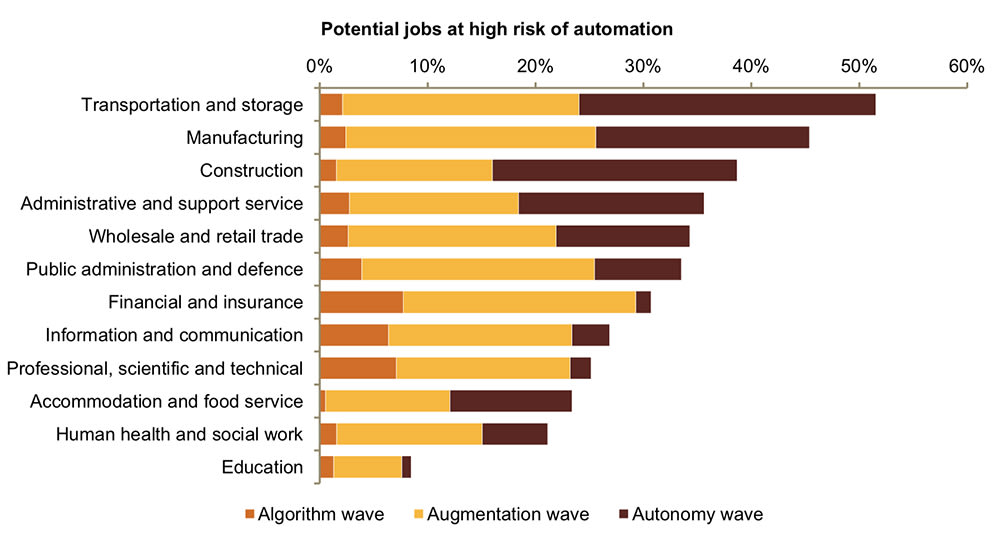Construction is likely to see the third highest percentage of jobs replaced by automation, behind transportation and manufacturing, according to consultant PwC.
In a report, Will robots really steal our jobs? PwC identifies three waves of automation between now and the mid-2030s: algorithm wave, augmentation wave and autonomy wave.
In the first wave up to the early 2020s, relatively few jobs will be automated but financial services could be relatively highly impacted
Up to 30% of existing jobs could be impacted by the mid-2030s, with the transport, manufacturing and retail sectors particularly affected. In construction about 40% of jobs could be replaced by automation across the three waves – with more than half of these most likely to be lost in the third wave as robotics take over routine tasks, the study shows.
The research analysed the tasks and skills involved in the jobs of more than 200,000 workers across 29 countries, including over 5,500 workers in the UK.
The study suggests that more women will initially be impacted by the rise of automation, whereas men are more likely to feel the effects in the third wave by the mid-2030s. This is due to the types of tasks that are more susceptible to automation and the current gender profiles of employment by sector.
Transport stands out as a sector with particularly high potential for automation in the longer run as driverless vehicles roll out at scale across economies, but this will be most evident in the third wave of autonomous automation (which may only come to maturity in the 2030s).
In the shorter term, sectors such as financial services could be more exposed as algorithms outperform humans in an ever-wider range of tasks involving pure data analysis, says the report.
Potential rates of job automation by industry across waves

Source: PIAAC data, PwC analysis
John Hawksworth, chief economist at PwC, commented: “We don’t believe that automation will lead to mass technological unemployment by the 2030s, any more than it has done in the decades since the digital revolution began.
“In the long run, AI, robotics and related technologies should not only make a significant contribution to UK GDP of up to 10%, but should also generate enough new jobs to broadly offset the potential job losses associated with automation.
“But we should not be complacent about the coming waves of automation: there will be challenges to many workers to adapt to these changes through enhancing their skills and retraining for new careers in some cases. Governments, businesses, trade unions and educational providers will all have a role to play in helping people through this transition.”
In the final wave, PwC predicts that AI will be able to analyse data from multiple sources, make decisions and take physical actions with little or no human input. The share of jobs that could be impacted by automation is estimated to rise to 30% by the mid-2030s, as autonomous robots and driverless vehicles roll out more widely across the economy.
PwC analysis suggests that this is the phase when many more manual tasks could become capable of being automated, pushing sectors like transport, manufacturing and retail to the top of the likely automation list.
This is also the phase when men are likely to be more impacted than women, due to their greater share of employment in manual jobs in areas such as driving, factories and warehouses. This is also true for less-educated workers, as the variation between education level widens.
However, PwC predicts that AI and other related new technologies will also boost productivity, income and wealth. As this additional income and wealth is spent or invested, it will generate increased demand for human labour in less automatable sectors.
PwC’s economic modelling suggests that this job creation effect will broadly offset the potential job losses associated with automation in the long run.
Euan Cameron, UK artificial intelligence leader at PwC, said: “Our research shows that the impact from automation and AI will be felt in waves, with more routine and data tasks hit first. But just because businesses and people aren’t feeling the impacts right now, there is no excuse not to start planning for the future.
“AI technology is getting more sophisticated every day and businesses need to understand how, where and when their people are likely to be affected in the future. Those that understand the risks and opportunities can start upskilling their people and adapting their businesses, rather than simply reacting when it’s too late.
Download the report here.
Image: Phuchit/Dreamstime.com
In the long run, AI, robotics and related technologies should not only make a significant contribution to UK GDP of up to 10%, but should also generate enough new jobs to broadly offset the potential job losses associated with automation.– John Hawksworth, PwC












